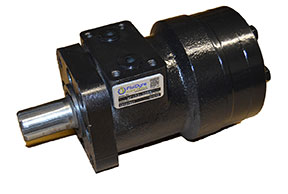White Paper – Why Bigger is Not Always Better
 Hydraulic orbital motors are common actuators found on a variety of hydraulics systems, from conveyers in factories, to wheel drives on mobile equipment. When orbital motors wear out over time their efficiency drops. The tell-tale symptoms of lost of power, speed reduction, and leaking seals manifest. The first thought is that this motor must not be large enough. When this happens the end-user will call into their hydraulic supplier with an unintentionally abstruse request, “I would like the same motor but bigger”. Frequently, these customers are asking for a replacement to an existing orbital motor with the same mounting, shaft size, and porting but with a larger displacement. They believe changing to a larger displacement is fairly easy and will fix their lack of power and speed issues. Hydraulic suppliers find after they have replaced a customer’s motor, the customer will return it with the same problem(s). As sure as the sun rises in the east and sets in the west, end-users tend to believe they thoroughly checked the rest of the hydraulic system, added new oil and changed all the filters. Immediately after the new motor is installed, it is still having the same problem. It is running even slower than before. The end-user calls the hydraulic supplier and arranges to return the motor. They want to purchase an even larger displacement motor. However, to do so, without entirely understanding the application can further lead to inadvertent complications in their system.
Hydraulic orbital motors are common actuators found on a variety of hydraulics systems, from conveyers in factories, to wheel drives on mobile equipment. When orbital motors wear out over time their efficiency drops. The tell-tale symptoms of lost of power, speed reduction, and leaking seals manifest. The first thought is that this motor must not be large enough. When this happens the end-user will call into their hydraulic supplier with an unintentionally abstruse request, “I would like the same motor but bigger”. Frequently, these customers are asking for a replacement to an existing orbital motor with the same mounting, shaft size, and porting but with a larger displacement. They believe changing to a larger displacement is fairly easy and will fix their lack of power and speed issues. Hydraulic suppliers find after they have replaced a customer’s motor, the customer will return it with the same problem(s). As sure as the sun rises in the east and sets in the west, end-users tend to believe they thoroughly checked the rest of the hydraulic system, added new oil and changed all the filters. Immediately after the new motor is installed, it is still having the same problem. It is running even slower than before. The end-user calls the hydraulic supplier and arranges to return the motor. They want to purchase an even larger displacement motor. However, to do so, without entirely understanding the application can further lead to inadvertent complications in their system.
[lab_subscriber_download_form download_id=10]
[lab_landing_page]

